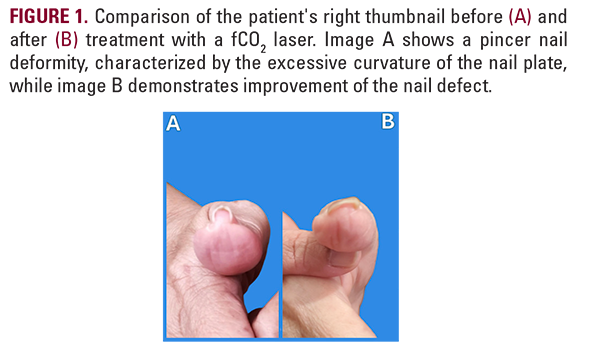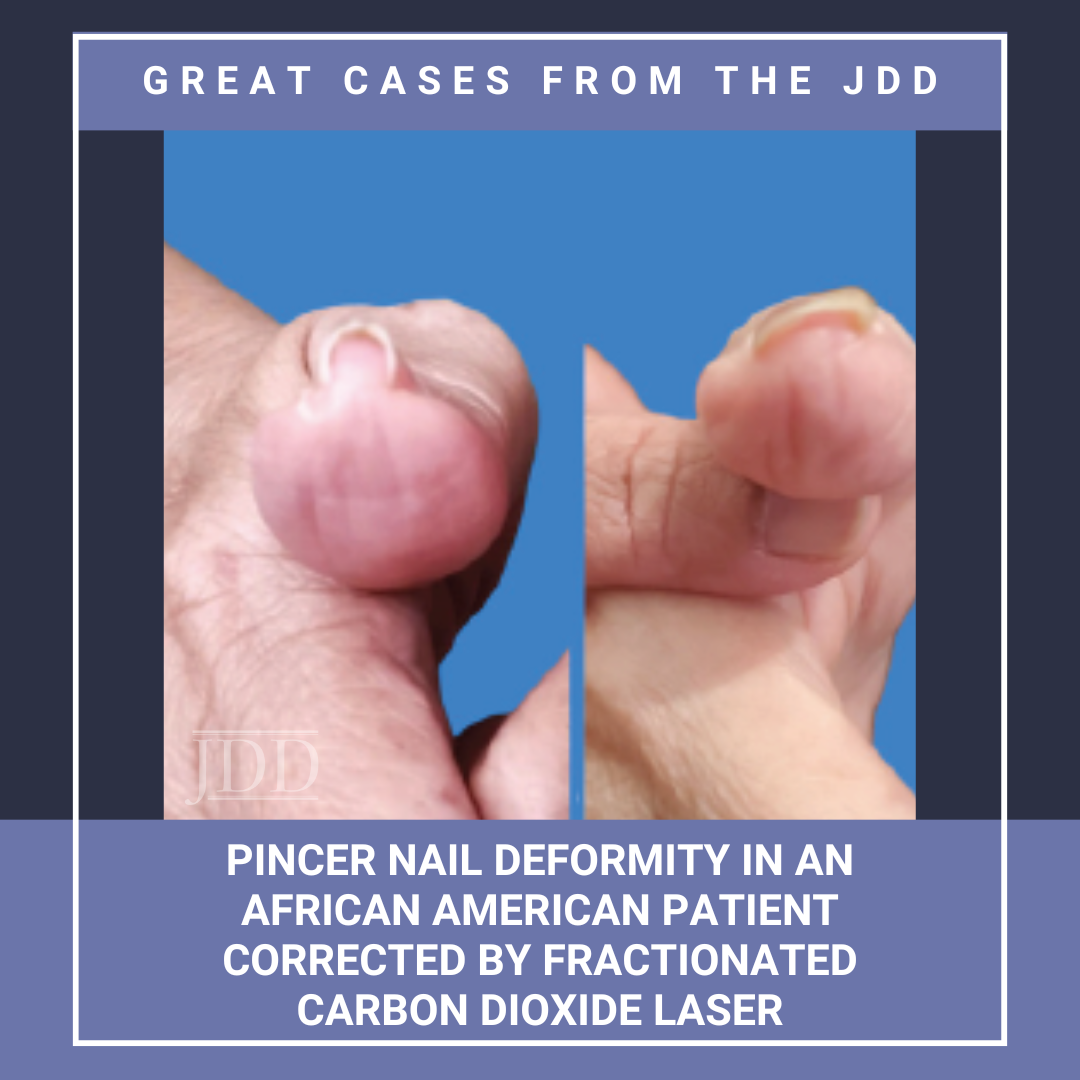Introduction
Pincer nail deformity is a painful nail condition characterized by excessive transverse curvature of the nail plate that pinches the surrounding tissue.1 This condition primarily involves the toenail of the hallux and is more frequently observed in older individuals.1 Management of a pincer nail typically involves nail braces or surgical removal.1 These managements usually fall short of providing long-term relief and satisfaction cosmetically.1
Fractionated Carbon Dioxide (fCO2) laser therapy offers an advanced option in treating severe cases. fCO2 laser can precisely target the nail matrix without causing extensive damage to surrounding tissues.2 However, laser treatment for skin of color patients presents with more complexity, including higher risks of post-inflammatory hyperpigmentation (PIH) and scarring.3 These complications are more common in individuals with darker skin tones. Risk of hyperpigmentation, particularly in skin of color patients, deters many clinicians and patients from utilizing fCO2.4 Research indicates that up to 16% of individuals with skin of color may develop hyperpigmentation after laser procedures.4 In addition to other potential complications, such as scarring.4 Advances in laser technology have made it possible to minimize these risks if appropriate settings are used.5 Customized treatment protocols and proper post-treatment care have been shown to reduce the risks of adverse outcomes, highlighting the need to address specific concerns, especially in patients with skin of color, and empower them with confidence in their treatment options.5
Case Description
A 78-year-old African American female (Fitzpatrick type V) presented with a painful right thumbnail deformity that had been present since September 2021. She reported significant pain that impaired her ability to perform daily activities. Prior treatments, including an incision and drainage (I&D) with matricectomy, and later trimming of the distal nail with application of a nail brace failed to provide relief. The patient’s medical history included diabetes mellitus (DM), hypertension (HTN), and a history of tobacco use, contributing to the complexity of her case. Physical examination revealed a tender pincer nail deformity characterized by inward-curving lateral edges.
Prior to the procedure, an eutectic mixture of local anesthetics (EMLA) was applied under occlusion for 60 minutes from the distal interphalangeal (DIP) joint to the fingertip. The patient was treated with a fCO2 laser (DEKA SmartXide DOT, Florence, Italy) in DOT mode. The laser settings included: a rectangular shape with a 60% size, a 4/10 ratio, and a power of 15 W. Spacing was set to 650 microns, with a dwell time of 500 microseconds and a stack of 1. The treatment area focused on the radial side of the lateral right thumb nail, including 1 to 2 mm of the lateral nail fold and 2 mm of the proximal nail fold, specifically targeting the nail matrix. The fCO2 laser was pulsed 4 times on the lateral endpoint to ensure adequate coverage.

Post-treatment care consisted of applying triamcinolone 0.1% ointment to the treated finger to reduce inflammation, followed by covering the area with Telfa dressing, gauze, and a coband wrap. The patient was prescribed cephalexin 500 mg to be taken 4 times daily for 14 days, and mupirocin ointment to be applied 3 times daily for 10 days to prevent infection.
Instructions were provided, and the patient was advised to keep the area clean and dry, avoid pressure on the finger, and monitor for signs of infection or complications.
The patient received a total of 5 treatments spaced over 18 months, with 3 to 4 months between each treatment. The progressive improvement was noted after each session, contributing to a gradual resolution of the nail defect.
Discussion and Future Directions
Herein, we present a case of pincer nail deformity in an African American patient. Pincer nail deformity is characterized by an excessive inward curvature of the nail plate.1 This results in pain and discomfort leading to functional impairment and, at times, secondary infections.1 Etiology of pincer nail is not well understood; however, contributing factors include systemic diseases.1 In older patients with chronic diseases such as osteoarthritis, structural changes in the nail matrix and the surrounding tissues are more common, and other factors such as repetitive trauma, tight footwear, and even genetic predisposition are thought to be triggers.1
While pincer nails most commonly involve the toenails, this patient’s presentation is unique due to its occurrence in the fingernail.1 In this case, her diabetes likely contributed to the exacerbation of the nail condition. Diabetic patients are 3 times more likely to develop onychomycosis, which is a well documented risk factor for the development of pincer nails.6,7
fCO2 laser treatment for pincer nails is an effective non-surgical treatment option for managing pincer nail deformities. fCO2 lasers can precisely ablate the nail matrix and facilitate reshaping the nail, allowing it to grow straighter over time.2 The precision of lasers allows for the removal of diseased or overgrown tissue while minimizing damage to surrounding structures.2 This approach is valuable for the elderly or those with co-morbidities like diabetes, where surgical risks are heightened.
Treating pincer nails in patients with skin of color, as in this case, introduces several challenges. Laser treatment poses a higher risk of PIH in darker skin tones, as heat generated by the laser can cause melanocytes to overproduce melanin.4 Proper patient selection and laser settings, such as lower energy levels and longer pulse durations, are essential to minimize these risks.5 Our patient demonstrated significant progress throughout the treatment course, highlighting the potential efficacy of fCO2 laser therapy. The patient’s satisfaction points underscore the importance of setting realistic expectations for patients undergoing laser treatment. Laser therapy may not yield immediate or dramatic results; however, instead provides gradual improvement. As seen in this case, nail plate correction of nail curvature can enhance patient’s comfort and quality of life.
Alternative treatment options for pincer nail deformity include nail braces, which apply gentle pressure to gradually straighten the nail over time.1 However, this approach often requires long-term use and may be insufficient for correcting severe cases.1 Surgical interventions, such as partial or total nail matrixectomy, may be necessary for refractory cases.1 However, these procedures carry a higher risk of complications, especially in elderly patients or those with conditions that impair healing, such as diabetes.
To our knowledge, this is the first documented case of successful treatment of a pincer nail deformity of the thumb using fCO2 laser in an African American patient (Fitzpatrick V). We propose that the fCO2 laser may serve as a safe and effective treatment option for pincer nail deformity in patients with skin of color, offering an alternative approach for refractory cases. This case highlights a unique presentation of pincer nail deformity and contributes to the current understanding of dermatological manifestations in patients with skin of color, highlighting the necessity of patient-centered care. Further randomized control trials with fCO2 laser are necessary to optimize fCO2 laser settings and treatment protocols, thereby strengthening the recommendation of fCO2 in pincer nail deformity in patients with Fitzpatrick skin types IV to VI.
References
-
- Huang C, Huang R, Yu M, et al. Pincer nail deformity: clinical characteristics, causes, and managements. BioMed Res Int. 2020;2020(1):2939850.
- Lane JE, Peterson CM, Ratz JL. Avulsion and partial matricectomy with the carbon dioxide laser for pincer nail deformity. J Am Acad Dermatol. 2003;48(4):571-573.
- Prohaska J, Hohman MH. Laser Complications. In: StatPearls [Internet]. Treasure Island, FL: StatPearls Publishing; 2024. Updated August 28, 2023.
- Liu CH, Shieh CS, Huang TL, et al. Evaluating the risk factors of post-inflammatory hyperpigmentation complications with Nd-YAG laser toning using LASSO-based algorithm. Appl Sci. 2020;10(6):2049. Available from: https://www.mdpi.com/2076-3417/10/6/2049
- Hu S, Atmakuri M, Rosenberg J. Adverse events of nonablative lasers and energy-based therapies in subjects with Fitzpatrick skin phototypes IV to VI: a systematic review and meta-analysis. Aesthet Surg J. 2022;42(5):537-547.
- Robbins JM. Treatment of onychomycosis in the diabetic patient population. J Diabetes Complications. 2003;17(2):98-104. doi:10.1016/s1056-8727(02)00199-x
- Shin WJ, Chang BK, Shim JW, et al. Nail plate and bed reconstruction for pincer nail deformity. Clin Orthop Surg. 2018;10(3):385-388. doi:10.4055/cios.2018.10.3.385
SOURCE
Collins, Alexia, et al. “Pincer Nail Deformity in an African American Patient Corrected by Fractionated Carbon Dioxide Laser.” Journal of drugs in dermatology: JDD 24.7 (2025): 700-701.
Content and images used with permission from the Journal of Drugs in Dermatology.
Adapted from original article for length and style.
Did you enjoy this JDD case report? You can find more here.

